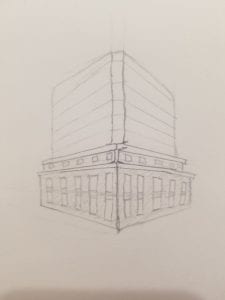The Hapag Lloyd building in Valparaiso inspired me for this post, if you don’t remember it, I’ve included a quick sketch that may remind you of this distinct port authority office right near the coast. The glaring part of this building is the contrast between the international style of the top half in contrast to the neoclassical facade of the bottom half. Since Valparaiso is a UNESCO site, the facades of these old buildings could not be changed, so when the Hapag Lloyd company took over, they kept the old facade but built upwards, in a completely different style. The windows of the old facade now have the same blue glass windows that the top half does, making it look like someone stuffed a big glass tube into the old building, and it is full to the brim. This particular building, which is not very successful in its renovation attempts, made me wonder what other buildings that have been renovated in contemporary times did correctly. The Precolombian museum was a renovated old building, but it is much more successful in that way. Is it simply because it doesn’t have a boring glass cube sticking out of the top? Perhaps, but it comes down to decorum– is it an effective/appropriate use of the local history to make a building like the Hapag Lloyd HQ? Here the answer is no. The blue glass windows on the lower half of the building make it seem like the central glass structure reaches all the way to the ground and the stone facades are simply slapped on to the sides. There is no continuity between the two halves of this building, and it takes an interesting concept/potential and completely fails at executing it, unlike the renovations of the Precolombian museum, or so many other projects that have revived classical/neoclassical buildings in a contemporary way.
Government Buildings
Materiality & Structures in Chilean Infrastructures
Chilean architecture often shows or mimic the materiality. Throughout the duration of the trip, I have learned that many buildings in Chile embraces materiality and expose structures and mechanical works. Many buildings around here are made of strengthen concrete in order for it to withstand earthquakes. The concrete is then left exposed to show the infrastructure of the building. This occurs in many types of infrastructure ranging from metro stations, museum, monasteries and museum and school. They were all build in different eras but still represent the same idea.
First are metro stations. Some were built more than 20 years ago and some were built this past year.a majority of them are located underground, but there are exceptions. Underground infrastructures are made of concrete. The concrete are often smashed like brutalist concrete with a large structural beam supporting the weight above and mechanical wiring exposed. The stations above ground are often made of copper or metal. The different pieces are then bolted together to create the infrastructure. All the bolts and metal are left exposed like the stations underground.
Underground Station Structures
Underground Station Material Patterns
Above Ground Station Materiality
Underground Station Structural Joint
Second are local monasteries and museums in Santiago. The Precolombino Museum and the monastery are both made of concrete and glass. The glass shows the lightness of the structure and the concrete shows the roughness of it. The way concrete is pour in Chile often leaves a unique pattern that looks like wood on the surface of the concrete. Sometime Chilean architecture uses one material to mimic another. In this case it is wood, because there are more than 100 difference species of trees. This technique allows the concrete to keep up its materiality and let it mimic wood.
Monastery Material Pattern
Third are educational institution. Many schools we visited uses the same materials. University Adolfo Ibanez is made entirely of concrete. However, it breaks away form the traditional style of Chilean concrete pouring. Instead of a rough pattern, it embraced a smooth concrete surface and still embrace the idea of exposing the material. The school also brings back the importance of wood to Chilean culture by utilizing it in the architecture.
Educational Insitution Materiality Differentiation






